#1 Applications Penetration Testing Services (Trusted by 1000+ Teams)
We uncover vulnerabilities across your web, mobile, and cloud applications through expert-led manual pentesting powered by continuous automation. Every test follows OWASP ASVS/WSTG and CVSS v4.0 standards, mapping to CISA KEV and compliance frameworks so you fix what matters first.

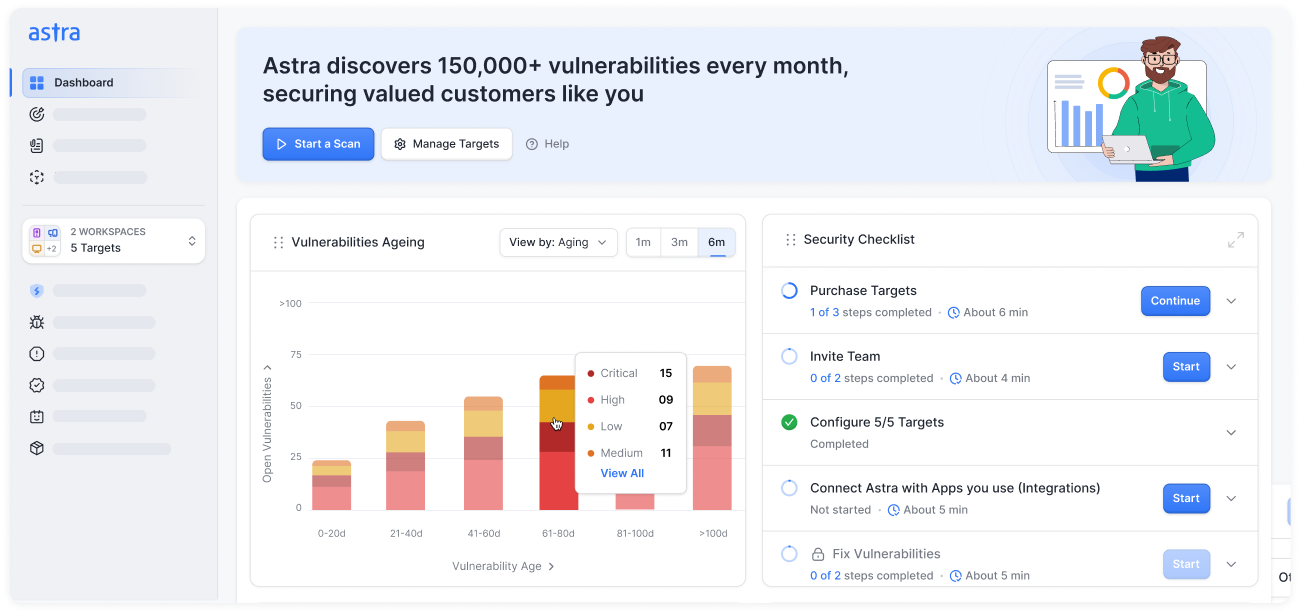










Why choose Astra Security’s application penetration testing services?
Experience deep-dive testing designed for modern engineering and compliance teams, blending expert-driven pentesting, smart automation, and continuous protection
- Focus on real vulnerabilities across your web, mobile, and API applications with noise-free detection logic
- Our experts vet false positives so you don’t waste hours validating noise
- Mark verified issues once to skip them in future scans
- Get expert vulnerability reviews for faster prioritization
- Cut manual tuning as our AI-first vulnerability scanner adapts tests to your app stack
- Context-aware analysis improves accuracy & guidance with every scan
- Use machine learning models that evolve from real-world exploit data
- Scale testing without increasing security headcount
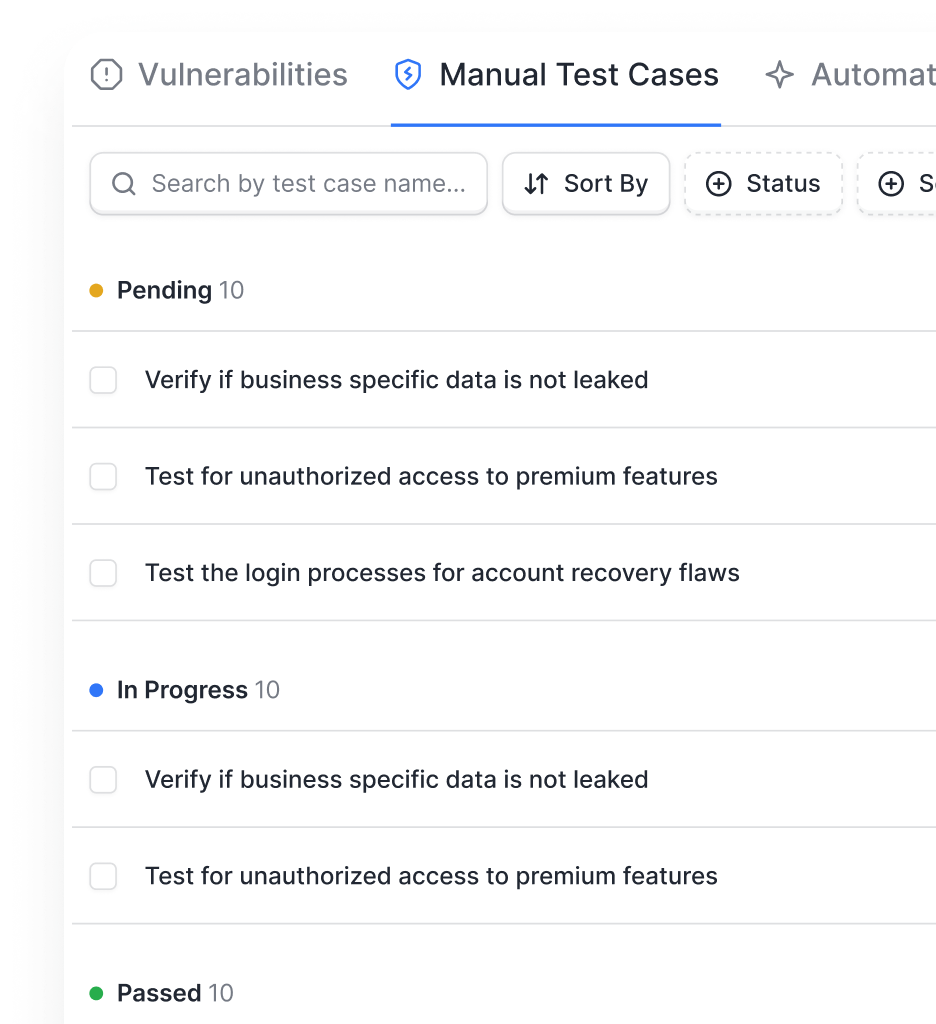
- Get continuous protection across your applications, APIs, and backend environments
- Avoid alert fatigue with business-impact optimized vulnerabilities & expert-tuned pentests
- Stay compliant with automated reports, verified fixes, and targeted automated rescans
- Cut false positives and reduce total cost with managed accuracy pentests
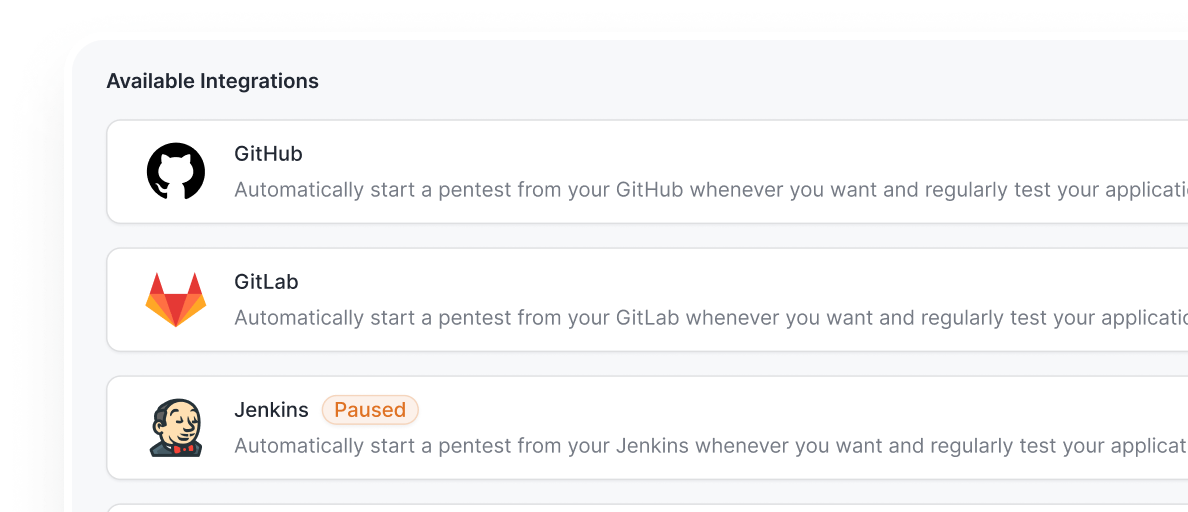
- Integrate testing seamlessly into CI/CD workflows (GitHub, GitLab, Jenkins, Bitbucket, & more) with zero release delays
- Automate scans, Slack vulnerability alerts, and JIRA ticketing to cut manual work
- Shorten the mean time to remediate with seamless vulnerability workflows
- Maintain speed-to-market without compromising security
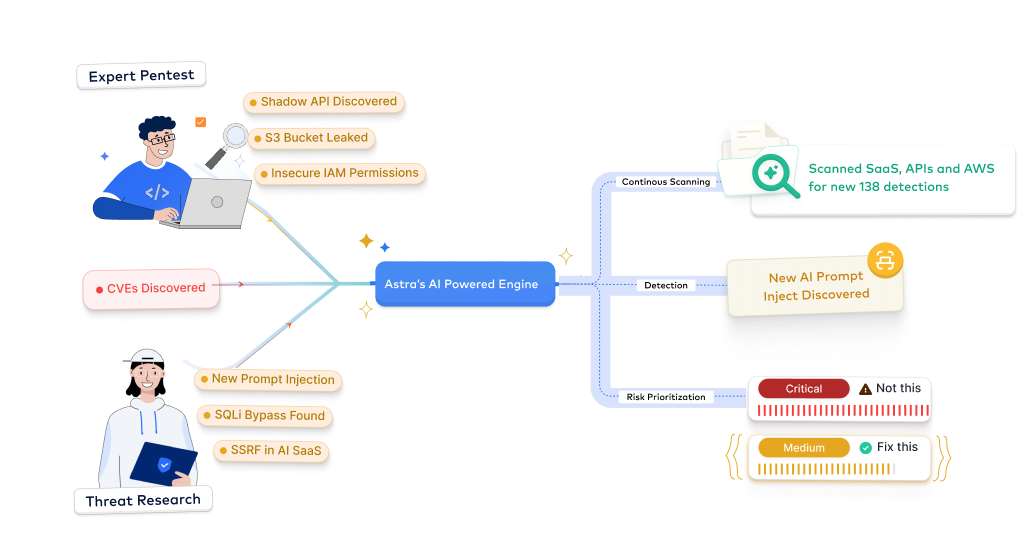
- Generate audit-ready reports for ISO, PCI, SOC 2, HIPAA, GDPR, OWASP, NIST, and more
- Accelerate certification with simplified expert-led guidance
- Demonstrate security maturity to shorten sales cycles
- Turn compliance readiness into a sales advantage

Simulate real-world attacks, uncover hidden flaws, and strengthen your defenses with Astra’s expert-led application penetration testing services starting at $5,999.
Start TrialAstra's 7-Step Pentest Process
How our applications penetration testing services work
Here’s how Astra’s experts deliver continuous, compliance-ready application security across your stack..
Discovery & Scoping
- Identify all in-scope web applications, APIs, cloud infras, domains, and subdomains for testing.
- Define parameters, environments, and integrations to ensure complete coverage.
- Align the assessment scope with relevant compliance frameworks such as PCI DSS, ISO 27001, SOC 2, or HIPAA.
- Personalized setup to maintain visibility throughout the engagement.
Outcome: Outline a mutually-agreed compliance-guaranteed scope and a clear roadmap to audit readiness.


Authentication Setup
- Establish secure authentication workflows for behind-login testing across user roles, APIs, and SSO flows.
- Integrate credentials, tokens, and session configurations to enable deep authenticated coverage.
- Ensure safe testing within staging or production replicas without disrupting business operations.
- Standardized authentication templates for future tests to streamline recurring assessments.
Outcome: Get full-depth testing coverage without risking business downtime or continuity.
Automated Baseline
- Run continuous automated scans across your applications, including APIs consumed and cloud, to detect OWASP Top 10, CVEs, business logic flaws, and misconfigs
- Leverage Astra Security’s tuned detection engine for comprehensive baseline coverage, automated cloud security config review (AWS/GCP/Azure), and minimized false positives
- Correlate automated findings with prior assessments to maintain historical visibility
- Deliver continuous monitoring data supporting ongoing compliance & audit preparation
Outcome: Gain a comprehensive, continuous threat baseline ready for immediate action and audit reporting.


Manual Pentest & Risk Scoring
- Our experts exploit post-scan findings with AI test cases to validate chaining, impact, create PoCs, and offer prioritized fixes.
- Evaluate each application & consumed API finding based on exploitability, business impact, and compliance relevance
- Apply contextual CVSS scoring to prioritize remediation per organizational risk appetite, certifications, or regulatory exposure
- Generate clear risk summaries to guide both technical and executive decision-making
Outcome: Receive prioritized, actionable risk intelligence focused on business & regulatory exposure.
Remediation Support
- Deliver detailed, developer-focused remediation steps validated by our expert pentesters
- Provide reproducible PoCs, payloads, and configuration guidance for faster fixes
- Collaborate directly with your engineering team to verify patch effectiveness
- Get documented remediation evidence aligned with audit and compliance requirements.
Outcome: Achieve faster, verified fixes supported by our team and documented for full compliance.


Re-Scan & Validate
- Conduct targeted re-tests to confirm successful remediation and eliminate residual risks.
- Schedule recurring scans to detect regressions after updates or infrastructure changes.
- Capture time-stamped validation evidence for audit readiness and certification renewals.
- Maintain a verified security baseline that demonstrates continuous improvement over time.
From startups to fortune companies,
1000+ companies trust Astra












































.webp)





Experience precision, speed, and zero false positives with Astra’s applications penetration testing services.
Request Pentesting ServicesTypes of application penetration testing services
Explore our full suite of application pentesting services designed for every layer of your security stack.

Web Application Penetration Testing Services
- Simulate real-world attacks to uncover OWASP Top 10, CWE, SANS 25 flaws, and authentication bypasses
- Validate fixes quickly with developer-ready PoCs and automated verification rescans
- Compliance-ready for ISO, SOC 2, PCI DSS, HIPAA, CERT-In, NIST SP 800-115, and more

Mobile Application Penetration Testing Services
- Test iOS and Android apps for insecure data storage, reverse engineering, and business logic flaws
- Identify API-level risks between mobile apps and backend systems
- Maps to OWASP Mobile Top 10, PTES, CVSS, GDPR, HIPAA, and more

API Penetration Testing Services
- Discover shadow, zombie, and undocumented APIs to prevent data leaks and unauthorized access
- Run authenticated scans across REST, SOAP, and GraphQL APIs
- Aligns with OWASP API Top 10, PCI DSS, GDPR, SOC 2, and ISO 27001

Cloud Application Penetration Testing Services
- Assess configurations, access controls, and integrations for cloud-hosted applications across AWS, GCP, and Azure
- Identify privilege escalation, misconfigurations, and exposed endpoints
- Compliance-ready for OWASP Kubernetes Top 10, ISO, SOC 2, NIST, CIS, PCI DSS, and CSA

Desktop & Enterprise Application Pentesting
- Evaluate desktop, thick-client, and hybrid enterprise apps for memory flaws, injection attacks, and privilege misuse
- Simulate insider and external attack scenarios with authenticated testing
- Complies with PTES, OWASP, NIST SP 800-115, and ISO 27001
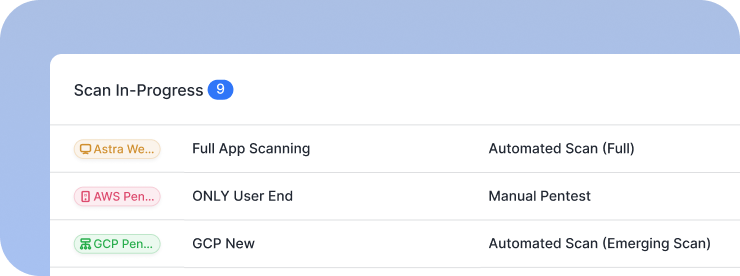
AI & LLM Application Pentesting Services
- Simulate adversarial and prompt injection attacks on AI-powered and LLM-based applications
- Test for data leakage, model manipulation, and insecure API integrations
- Compliance-ready for SOC 2, GDPR/CCPA, ISO/IEC 42001, and EU AI Act
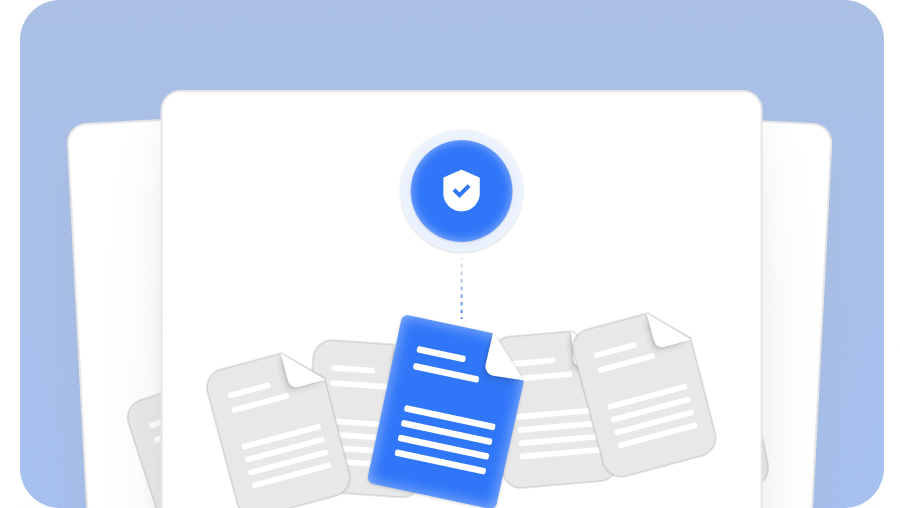




Secure every layer of your applications with Astra Security’s expert-led pentesting services.
Book a DemoAstra Security vs traditional vendors
See how our modern approach to application penetration testing delivers smarter, continuous, and compliance-ready protection.
Experience the Astra Security difference: faster, smarter, compliance-ready pentesting.
Pentesting as a service, tailored for your industry
Continuous penetration testing and compliance mapping services built for ISO, SOC 2, HIPAA, PCI DSS, and more.

- Secure financial systems and payment workflows from logic flaws
- Deliver actionable fixes and maintain PCI DSS, ISO 27001, SOC 2, DORA compliance, and more
- Standards: OWASP, PTES, CVSS

- Protect patient data and secure APIs across web, mobile, and cloud
- Uncover hidden PHI exposures and validate HIPAA, ABHA, and more
- Standards: OWASP, PTES, NIST, CVSS

- Accelerate app security with DevSecOps integration and continuous scans
- Detect vulnerabilities with AI-driven validation and ensure ISO 27001, SOC 2, GDPR compliance and more
- Standards: OWASP, PTES, CVSS, NIST SP 800-115

- Protect customer data and secure payment flows from BOLA/IDOR risks
- Empower developers with guided remediation and PCI DSS, ISO 27001, SOC 2 compliance and more
- Standards: OWASP, PTES, CVSS

- Fortify cloud, container, and on-prem systems with authenticated tests
- Monitor and validate vulnerabilities to prevent downtime; comply with NIST, ISO 27001, SOC 2, CREST, Cert-In, and more
- Standards: OWASP, PTES, NIST, CVSS

- Discover shadow APIs and secure cloud services
- Deliver fast, developer-friendly fixes; ensure GDPR, ISO 27001, SOC 2 compliance
- Standards: OWASP, PTES, CVSS
Simulate real-world attacks, uncover hidden flaws, and strengthen your defenses with Astra’s expert-led application penetration testing services starting at $5,999.
Start TrialOur pentesters? World class, certified & contributors to top security projects
We find the bugs before the bad guys do
Our team stays ahead of the curve in the ever-evolving world of web security

.avif)
.avif)
.avif)




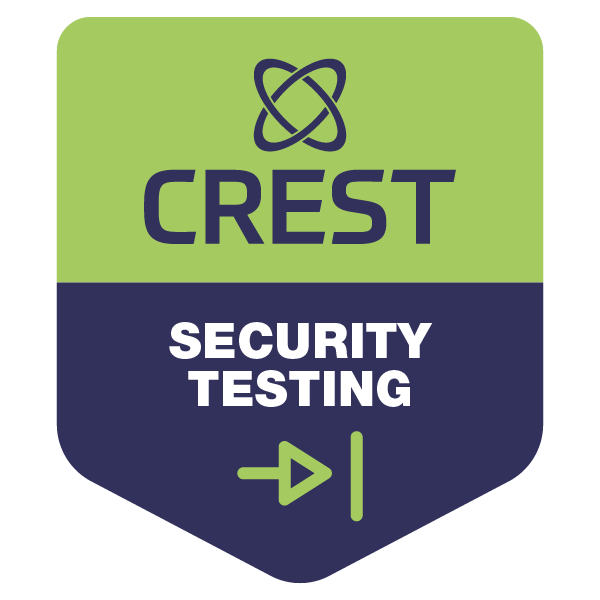
Stay compliant throughout the year
Understand our industry-specific pentests as a service plans designed to meet your compliance, scale, and security needs.
- Get compliance-ready year-round for ISO 27001, SOC 2, GDPR, HIPAA, PCI DSS, CREST, CERT-In, CIS Controls, NIST, & more
- Receive actionable insights from continuous pentesting and expert-led remediation guidance
- Track compliance progress with the Astra Security Compliance View, providing executive-friendly and technical views

- Continuously scan your applications, including web, mobile, and APIs, for new CVEs, OWASP Top 10, and business logic flaws introduced after updates.
- Validate vulnerabilities in real time with expert triage, automated rescans, and regression checks across environments.
- Track application-specific risks, authenticated test coverage, and fix progress in the Astra Vulnerability View for complete engineering visibility.

- Maintain audit-ready reports without manual effort
- Reduce risk exposure with real-time detection and validation
- Prioritize remediation based on business impact and compliance requirements
- Demonstrate security maturity to clients, regulators, and internal stakeholders


Frequently asked questions
What are application penetration testing services?
Application penetration testing services identify vulnerabilities across web, mobile, API, and cloud applications by simulating real-world attacks. This helps uncover flaws like broken authentication, misconfigurations, and insecure integrations that could be exploited by attackers.
What is included in Astra’s application penetration testing services?
Astra’s application pentesting includes comprehensive vulnerability scanning, manual penetration testing, authentication and session management reviews, configuration analysis, and business logic testing. You also receive detailed reports, prioritized risk scoring, remediation guidance, and post-fix validation scans to ensure complete security.
Why is application penetration testing important?
Application pentesting helps prevent data breaches, downtime, and compliance issues by identifying and fixing security gaps before attackers do. It protects customer data, safeguards business continuity, and supports certifications like ISO 27001, SOC 2, HIPAA, PCI DSS, and GDPR.
What methods do you use to assess my applications’ security?
We combine automated scanning, manual pentesting, and AI-driven analysis to detect both technical and logic-based vulnerabilities. Our gray-box methodology ensures realistic testing with full contextual awareness, while every finding is manually verified for accuracy and mapped to real business impact.
How often should I perform application penetration testing? Will I get a report after the assessment?
Automated scans should run continuously or at least weekly to catch new vulnerabilities early. A full-scale penetration test is recommended annually, or after major code updates, infrastructure changes, or new app launches. You’ll receive a detailed, compliance-ready report outlining vulnerabilities, their impact, and recommended fixes.
Can Astra help fix the vulnerabilities found during testing?
Absolutely. Our experts provide clear remediation guidance, PoCs, and direct developer support. Once fixes are implemented, we perform validation rescans to confirm closure, ensuring your applications stay secure post-remediation.











